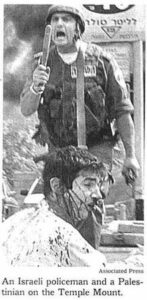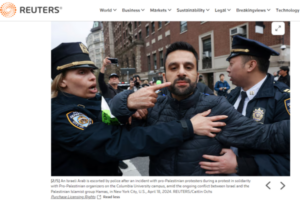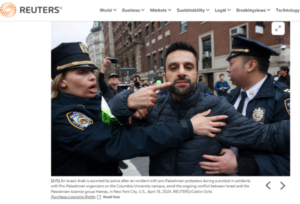This past Thursday, violence in the name of the Palestinian cause reached the gates of Columbia University – and it came paired with its usual mate: the Western media tendency to whitewash anti-Israel belligerence and cast the perpetrators as victims.
The story which played out last week in Morningside Heights bore an uncanny resemblance to an unforgettable bloody incident which transpired Sept. 29, 2000 in the Arab neighborhood of Wadi Joz at the outbreak of the Second Intifada.
On that Rosh Hashana eve, a taxi carrying three American Jewish yeshiva students took a short-cut through the Jerusalem neighborhood on the way to the Western Wall. Dozens of Arab residents attacked the taxi, pulled out passenger Tuvia Grossman and savagely beat him, stabbing him in the leg and pounding his head with a rock.
Yelling as loud as he could, Grossman momentarily stunned his attackers, buying himself an opportunity to flee to safety. He ran towards an Israeli border policeman, who protectively raised his baton, driving away Grossman’s attackers. The young American Jew was thus rescued from his Palestinian assailants.
It was at that moment that a photographer snapped a photo of the heavily bleeding Grossman in front of the shouting Israeli policeman in a menacing posture, capturing what became an iconic image.

The Associated Press’ false caption for the dramatic image, which was picked up in leading media outlets such as the New York Times, Chicago Tribune, The Wall Street Journal and elsewhere, misidentified the badly injured American Jewish youth as a Palestinian. The clear implication that the threatening Israeli police officer had beaten the supposedly Arab victim.
The photograph, and its woefully erroneous caption, thus become an icon of anti-Israel media bias.
As Andrea Levin, executive director of Committee for Accuracy in Middle East Reporting and Analysis, told the JTA at the time, the photo, with its erroneous caption, indicated “ingrained assumptions,” namely, “that there is only one victim in this conflict, the Palestinian.”
Fast forward nearly 25 years and thousands of miles westward to the leafy campus of Columbia University, where Palestinians and their supporters, who last week established an illegal tent encampment and threatened, attacked and disrupted student life, were anything but victims.
According to video footage and his own account, anti-Israel protesters at the Ivy League institution attacked Israeli Arab Yoseph Haddad, an outspoken supporter of Israel, who arrived at the campus for his scheduled lecture. Sharing a video of his assault, he wrote on X (formerly Twitter): “I was physically attacked by pro-terror protesters before my lecture at Columbia University. Instead of a lecture, I had to file a complaint with the police. They may have drawn blood but these cowards will never stop me.”
I was physically attacked by pro-terror protesters before my lecture at Columbia University. Instead of a lecture, I had to file a complaint with the police. They may have drawn blood but these cowards will never stop me. pic.twitter.com/X3G0zXSsVx
— יוסף חדאד – Yoseph Haddad (@YosephHaddad) April 19, 2024
The video clearly shows an attacker with his face covered punching Haddad in the face. Like the brutalized Grossman, Haddad quickly approached nearby police officers, and said he pointed out his assailant.
As in 2000 in Jerusalem, a photographer was on hand to capture the encounter. As if replaying the infamous media fiasco from the violent beginning of the bloody Second Intifada, here too a major news agency confused perpetrator and victim, falsely depicting the victim of anti-Israel violence as belonging to the supposedly victimized Palestinian contingent.

Reuters published captions of Haddad misidentifying him as a pro-Palestinian protester (screenshot above): “A demonstrator is detained during a protest in solidarity with Pro-Palestinian organizers on the Columbia University campus, amid the ongoing conflict between Israel and the Palestinian Islamist group Hamas, in New York City, U.S., April 18, 2024. REUTERS/Caitlin Ochs”
Anti-Israel protesters alleged police “repression of pro-Palestinian protesters” and compared the New York police to the KKK, a false narrative which turned the purportedly detained and ostensibly pro-Palestinian Haddad into a victim of anti-Palestinian police repression.
Haddad flagged Reuters’ erroneous captions, and CAMERA contacted editors to reiterate the request for correction. Reuters responded that the news agency regretted the error and corrected.

But the “corrected” captions whitewash the attack on Haddad as nothing more than an unspecified “incident”: “An Israeli Arab is escorted by police after an incident with pro-Palestinian protesters during a protest in solidarity with Pro-Palestinian organizers on the Columbia University campus, amid the ongoing conflict between Israel and the Palestinian Islamist group Hamas, in New York City, U.S., April 18, 2024.”
CAMERA reiterated its request that Reuters clarify that the “incident” was a violent assault on Haddad.
Moreover, Reuters’ article covering the Columbia University Gaza tent encampment unrest in which more than 100 were arrested depicted the protesters as merely “against Israel’s actions in Gaza,” ignoring the pro-Hamas expressions which have taunted Jewish students.
One protester near campus shouted: “We are all Hamas.” Another screamed at two Jewish students just outside Columbia’s gates: “Never forget the 7th of October. That will happen not one more time, not five more times, not 10…100…1000…10,000…The 7th of October is going to be every day for you.”
“Never forget the 7th of October. That will happen not one more time, not five more times, not 10…100…1000…10,000…The 7th of October is going to be every day for you.”
Protestors screamed this at two Jewish @Columbia students right outside campus gates tonight. pic.twitter.com/VYp0tFudGj
— Jonas Du (@jonasydu) April 19, 2024
By concealing the violent rhetoric and behavior at Columbia, media outlets not only risk turning perpetrators into victims. They also risk burying a festering problem which threatens to erupt into more harmful violence targeting American Jewish students.
Back to the prescient story of Tuvia Grossman, AP did commendably correct following an avalanche of criticism. The news agency also published a detailed follow up story on the attack that Grossman and his friends endured at the hands of the Palestinian mob (“American Jewish students carry grim reminders of Arab attack”).
But it’s far from clear that journalists across the board have gleaned the necessary lessons from the misreporting of Grossman’s ordeal which punctuated the start of the deadly Second Intifada.
The story is repeating itself. Journalists must urgently overcome their ingrained assumptions and willful partisanship before more American Jewish students – this time in New York –bear grim reminders of antisemitic and anti-Israel violence.
This article was originally published on CAMERA’s main website: camera.org.

